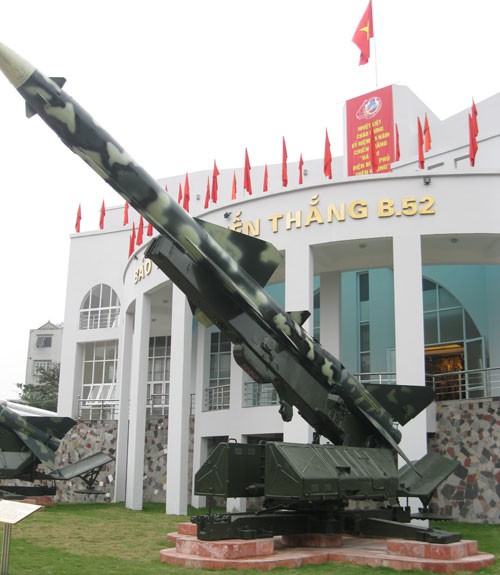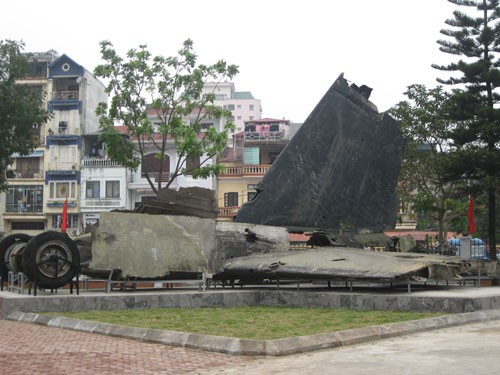(VOVworld) – The victory of the 12 day battle against the US carpet bombing in late December, 1972, went down in Vietnamese history as a miraculous exploit. The victory represented Vietnam’s fighting spirit and brainpower, which helped change the war situation leading to the national unification in the spring of 1975.
 |
The museum of victory over B52 bombers in Hanoi
|
The Vietnamese army was not surprised at the US Linebacker II operation to bomb Hanoi 40 years ago. In 1965, when the US bombed the Ben Cat area of Ho Chi Minh City, President Ho Chi Minh predicted that sooner or later, the US would use B52 bombers to attack Hanoi and northern Vietnam. The President ordered the Air Defence Force to prepare counter measures. Plans for weapons and human resources development to defeat B52 bombers got underway. Lieutenant-general Nguyen Xuan Mau, former Deputy Political Commissar of the Air Defence Force, told VOV: “The Air Defence Force compiled a handbook in 1968 on how to encounter B52 bombers. By the end of November, 1972, the final version was approved by Chief of Staff Van Tien Dung and the General Staff before being approved by General Vo Nguyen Giap. After that, we were proactive in our war tactics.”
The 1972 air battle showed the Vietnamese army’s flexibility and creativity. Its MiG21 fighter jets, SAM2 rockets, 100mm cannons and P35 radar confounded the US Air Force. Colonel Dinh The Van, former head of battalion 77, which shot down 4 B52 bombers, said: “Our battalion’s task was to protect the Ba Dinh area. That’s why we had to study all the weaknesses of B52 bombers, such as that they could be detected by heavy interference on the screen. B52 bombers often flew at an altitude of 10km, just the right distance to be targeted by a rocket. The larger and heavier B52 bombers were, the clearer the radar signals were. We also learned that if a B52 bomber was in its bombing radius, the F4 fighter jets would be out of range to fire.”
Lieutenant General Pham Tuan says B52 bombers were equipped with rockets and guns which are capable of destroying fighter aircraft. These bombers had strong support and could conduct night operations. According to Tuan, Vietnamese pilots had to practice flying at a very low or very high altitude to approach the American Stratofortress. Senior Lieutenant-colonel Vu Dinh Rang, pilot of MiG21, told VOV: “No country in the world had used MiG21 aircraft to fight B52 bombers. During the 12 days and nights of the bombardment, we could tell that the Americans were afraid of our air force. That’s why they bombed our inner-city airports. We had to use short runways to take off vertically for combat. Later on, we moved to outskirts airports, which the enemy hadn’t considered, for our sorties. Whenever our MiG21s flew a sortie, the combat formation of B52 bombers was forced to loosen, reducing interference and paving the way for our rockets and other ground fire.”
At that time, the Vietnamese People’s Army modified its weapons, including SAM2 rockets, which our adversaries considered incapable of hitting B52 aircraft. Lieutenant-general Nguyen Van Phiet, former head of battalion 57, said: “We had only SAM2 rockets to encounter B52 bombers. We did perform some modifications of rockets to enhance their capacity. For example, after SAM2 rockets were fired, they fell down due to interference. Technical experts from the Soviet Union and Vietnam managed to minimize these constraints. Warheads of SAM2 rockets exploded out in 1,200 pieces in 1965, but after renovation in 1972, 3,200 pieces were thrown out.”
 |
| Wreckage of B52 bombers |
Thanks to improved forces and war strategies, the army and people of Vietnam defeated the US air blitz on Hanoi, shooting down 34 B52 Stratofortresses. This victory forced the US to end its bombing of northern Vietnam and sign the Paris Accord in 1973, opening a strategic opportunity for Vietnam to eventually win the war against the US. The aerial victory 40 years ago has become a momentous history event, showing the brainpower and strategic vision of the Communist Party of Vietnam and President Ho Chi Minh.